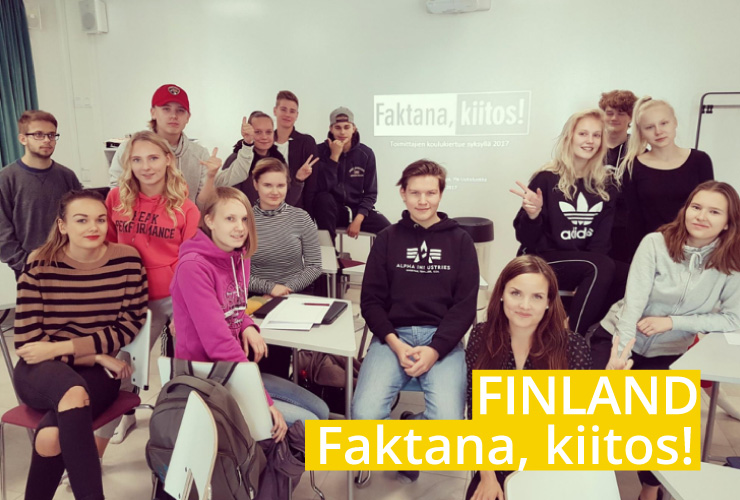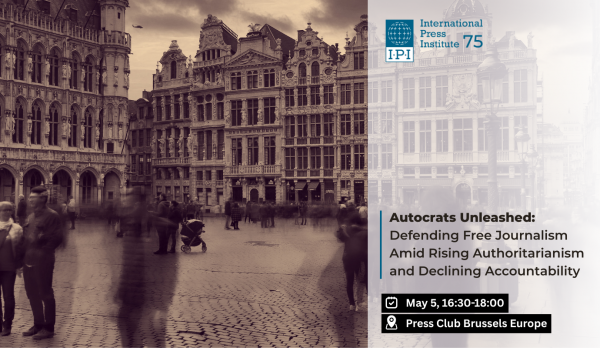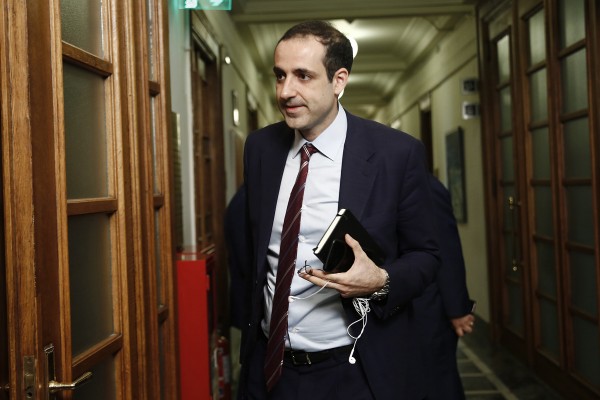When it comes to “fake news”, disinformation and hate speech, most media experts agree that a greater degree of media literacy and public trust in professional news media outlets are viable means to curb some of the most negative effects of the phenomenon.
Last autumn, a project called Faktana, kiitos! – roughly translated as Facts, please! – was launched in Finland. The aim of Faktana, kiitos! was to bring together journalists throughout Finland and send them to schools to share their expertise on journalistic practices and social responsibility, issues with which parents and teachers may not necessarily have experience.
Anne Leppäjärvi, the journalism-degree programme director at Haaga-Helia University of Applied Sciences in Helsinki and the producer of Faktana, kiitos!, told IPI that the project began when enough journalists expressed their concern over the effect that “fake news”, fake media outlets and related concepts have on the public.
“What we considered most troublesome was that there was a growing sentiment against journalists,” she said. “And we wondered: when people are against journalists, do they really understand what they are against? We are not on different sides here.”
Leppäjärvi continued: “We don’t want to be apologetic for being journalists. We want to promote the values of journalism and the importance of a free press. Because if the public does not want to protect these values, we are in big trouble, even in Finland.”
The idea for Faktana, kiitos! was born out of these common concerns, Leppäjärvi said.
“We decided we would go to schools and talk about what our profession is about,” she recounted. “How do you produce journalism? What are its motives? How can you evaluate information?”
Too much information
Leppäjärvi observed that it is not always clear to young people what the difference between journalism and other kinds of media is. Journalists, she said, have a very particular value system behind their work. The goal of Faktana, kiitos! is to communicate that.
One aim, Leppäjärvi said, is to teach audiences about responsibility.
“We want to make them realise that when they forward information, they are also responsible for the content,” she commented. “Have they thought about how that information was gathered and put together? Is it responsible to share something that you know might not be true?”
Reijo Kupiainen, a lecturer on media education at the University of Tampere, noted that from the point of view of media education, differentiating between different kinds of misinformation and half-truths can be tricky.
“Finnish fake news outlets are just a small part of the bigger picture,” he told IPI. “Additionally, we have all sorts of news and information coming from abroad, and sometimes the headlines in the mainstream media are clickbait, similar in form to those in less trustworthy outlets.”
Additionally, Kupiainen noted, it is hard to get clear numbers on the amount and types of “fake news” that are circulated in social media. This is why it is difficult, he said, to know exactly how much deceptive content an average person, for example a young social media user, is subjected to.
“To a regular youth, fake news may appear quite randomly in between everything else,” he commented. “Information bubbles are common in social media, though, so your feed is based on what kinds of groups and content you interact with.”
A study published in 2016 by the Finnish Newspapers Association showed that only one percent of junior high school students between the ages 13 and 15 considered “alternative” media outlets like MV Lehti and Magneettimedia reliable. Some 40 percent said they found it difficult to judge whether information found online is accurate. Three out of every four said they occasionally come across something that is dishonest, inaccurate or unclear.
However, Rekola noted, interpreting these results is not so simple.
“Naturally, when you name a known fake news outlet and ask people if they trust it, they will rarely say yes,” he said. “But when we are dealing with social media, the sources are not always so clear. Recognition and, thus, critical evaluation become more difficult.”
Well received
Leppäjärvi said the school tour has been well received so far, with 124 journalists having met with around 7,200 school students. Faktana, kiitos! ran from September to December 2017, and there are further plans to include journalism students in the project this spring as the rounds continue.
Faktana, kiitos! received a small grant which allowed it to create its own website, where all of the journalists available for school visits are listed. The project also received help in creating other material, such as the script given to visiting journalists to support them as they go through various topics.
The script, compiled by journalist and media education expert Pauliina Grönholm, includes sections on journalistic work, freedom of speech, distinguishing between “fake news” and accurate content, among others. Journalists who participate can mix and match categories, depending on the time available. The use of personal examples and open discussions during the visits are encouraged.
Every single school visit is valuable, Leppäjärvi said, as it also helps journalists ease their own frustration about the issues surrounding “fake news” and misinformation.
“Our project aims to counter the sense that there is just too much information out there without anyone knowing what is true,” she commented. “It would not be reasonable to just give up. I mean, we have always had propaganda. We need to understand the actors and the motives behind the phenomenon.”
For school students, the main value of the programme is in sparking interest in matters of public interest. Journalists can provide these students some insight into the journalists’ profession, including the ethical judgments they make and the value that a free press has in society.
“We are doing this for press freedom, quite simply,” Leppäjärvi said. “We want all the generations, teachers, parents and students, to understand the special mission journalism has, so they would be more willing to protect it. I do not want to see a situation where people no longer feel like they need journalists.”
RELATED ARTICLE: Finland remains resistant to ‘fake news’, disinformation
ABOUT THIS SERIES: IPI’s reporting project Contending with “Fake News” examines the particular dynamic around the “fake news” debate in five EU countries, offering a look a the sources, styles and goals of disinformation in each country as well as the extent to which that debate has affected public discourse, politics and press freedom. The series also profiles five initiatives that have adopted innovative solutions to addressing disinformation and building trust in fact-based journalism and that could potentially serve as models for similar efforts elsewhere. Read more.



